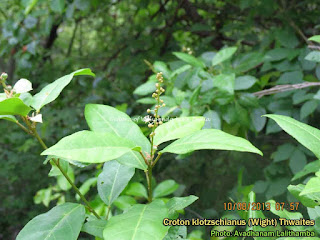
 Urginea coromandeliana Hook.f.
Urginea coromandeliana Hook.f.Drimia indica (Roxb.) Jessop
Family: Asparagaceae
English: Indian squill, white squill
Telugu: adavi ulligadda,
Malayalam: Kanthanga, Kattulli, Vishamangi
Description: Perennial; bulbous geophyte; bulb tunicated, white, 2.5-4 cm across, globose. Leaves radicle, 10-15 × 0.5-1 cm, thick, canaliculated, acute. Flowers drooping, dull green, 1 cm long, 3-4mm across, 3-merous, racemosely, laxly arranged on 15-30 cm long, stiff scape; pedicel 0.4-0.5 cm long. Perianth lobes 6 in 2 whorls of 3 each, linear oblong, tips of inner 3 puberulous. Stamens 6, inserted, connate with perianth lobes at base; anthers yellow, oblong. thin, campanulate. Ovary sessile, 3 loculed, ovules many in each cell; style filiform, stigmas capitate. Fruiting scape elongates to 40-60 cm long. Capsule 1cm across, deeply 3-lobed, loculicidal, 3-valved. Seeds orbicular, flat, 0.5 cm across, black.
Note: The Plant List treated this species as synonym of Drimia indica (Roxb.)Jessop. But due to the differences it is treated separately as per Gamble’s F.P.M and F.B.I.
Used in Ayurveda, Unani and Sidha. Poisonous, in large doses bulb is emetic and cathartic, in excessive doses is a narcotic acrid poison; nauseous bitter young bulbous roots expectorant and diuretic if taken in small doses. Juice of the leaves causes cutaneous irritation. Leaves heated and tied on stomach for stomachache. Bulb as cardiac stimulant, diuretic, for chronic bronchitis; bulb juice employed in small doses in asthma, cough and whooping cough; powder used in asthma and tuberculosis; fresh tubers ground and used as a poultice for the treatment of swelling, sprain and joint pains, antifungal, chitinolytic, antiangiogenic and proapoptotic; paste of bulb warmed along with jaggery and applied to remove corns; bulb paste given for abortion. Potent in vivo antitumor activity against growth of an ascites tumor, mouse mammary carcinoma. Veterinary medicine, fresh bulb for curing stomach pain of cow and buffalo; paste of tuber with cow urine applied locally on eczema, carbuncles, wounds and tumour; juice of bulb given in asthma and to promote reproduction; bulb of Urginea indica and tuberous roots of Ampelocissus tomentosa made into a paste and applied over abscess and sore throat; leaves of Andrographis paniculata along with those of Vitex negundo, Cardiospermum halicacabum, tubers of Curculigo orchioides and Urginea indica pounded and extract given for ephemeral fever. [CRC World Dictionary of Medicinal and Poisonous Plants]
Publications:
1. NATURAL TETRAPLOID OF URGINEA-COROMANDELIANA HK F
By: NAIK, VN
CURRENT SCIENCE Volume: 42 Issue: 12 Pages: 439-440 Published: 1973
2. CYTOLOGICAL EFFECTS OF GAMMEXANE ON SOMATIC CHROMOSOMES OF URGINEA COROMANDELIANA HOOK F
By: DATTA, N
CURRENT SCIENCE Volume: 35 Issue: 3 Pages: 75-& Published: 1966
3. Cytological effects of gammexane on somatic chromosomes of Urginea coromandeliana Hook. F.
By: NITYANANDA DATTA.
Current Science Volume: 35 Pages: 75-76 Published: 1966
4. Cytology of Urginea coromandeliana Hook [Liliaceae 2n = 20]
By: DATTA, NTTYANAKDA
SCI CULT Volume: 32 Issue: (2) Pages: 97-99 Published: 1966
Drimia indica:
1. Diversity of Drimia indica (Roxb.) Jessop and its relationship to Drimia nagarjunae using phenotypic traits and molecular markers
By: Alluri, Narendranath; Shivakameshwari, M. N.; Manohar, S. H.; et al.
INDIAN JOURNAL OF EXPERIMENTAL BIOLOGY Volume: 53 Issue: 6 Pages: 412-416 Published: JUN 2015
2. Herbal composition useful for treating mastitis, comprises combination of extracts of plants Emilia sonchifolia, Ficus racemosa, Musa paradisiaca, Artocarpus heterophyllus, Asparagus racemosus, and Drimia indica
Patent Number: IN201101012-I4
3. Anthelmintic and antimicrobial studies of Drimia indica (Roxb.) Jessop. bulb aqueous extracts.
By: Chittoor, M. S.; Binny, A. J. R.; Yadlapalli, S. K.; et al.
Journal of Pharmacy Research Volume: 5 Issue: 7 Pages: 3677-3686 Published: 2012
















































